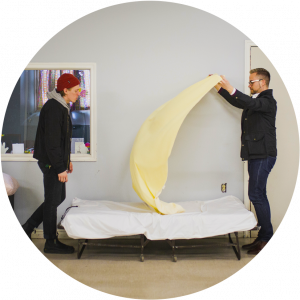The Issue
Individuals and families who experience homelessness are impacted by a mix of structural factors, system failures, and individual circumstances. These factors combined with the high cost of homes and rent, and record low vacancies have created a crisis for those seeking shelter within the GTA. Groups at increased risk of homelessness include Indigenous, Black, and racialized peoples, those experiencing intimate-partner violence, youth, refugees, seniors, people with disabilities, and individuals identifying as 2SLGBTQ. Shifting from managing homelessness to ending homelessness in the GTA will require a regional approach, including the creation of more supportive housing, adoption of more preventative initiatives, and improved coordination in the delivery of homelessness services.
6300
individuals using City of Toronto shelters – as of July 2021
+10%
More than 1 in 10 rental units across Toronto’s Census Metropolitan Area accumulated arrears between October 2019 and October 2020
47%
of tenant households lack affordable housing, spending 30% or more of their income on shelter costs
How we help
We aim to reduce the occurrence and duration of homelessness, prevent homelessness through early intervention, and reduce risks for those who are experiencing homelessness. Our approach is to support best practices in addressing homelessness, and to support those that present a clear understanding of populations disproportionately affected by homelessness across Peel, Toronto, and York Region. We support urgent and unmet needs through focused programs that address gaps in specific geographic areas or for particular populations. We will also increase funding for prevention and diversion-based practices, and system solutions to reduce the risk and frequency of homelessness for individuals. Community-level and systems-level solutions to homelessness, and initiatives which enhance service delivery coordination and/or leverage unique opportunities are encouraged.

Dave, United Way program participantMy kids and I had to move into a hotel last summer. I’m a frontline worker. I work at a grocery store, and I had saved up quite a bit of money, but the hotel just killed my savings. I was on my last few dollars. Luckily, my daughter mentioned that she was doing her schoolwork from the hotel to one of her teachers, and they connected me to Blue Door, a United Way-supported organization. Within a week, the agency had found us an apartment in a nice neighbourhood in Newmarket. It has two bedrooms, two bathrooms—it’s so nice, and we all finally have some space. They’ve sent over gift cards to help with groceries and household stuff, and connected my daughter to a peer support group. We would have definitely ended up on the streets if not for United Way. This experience showed me it’s ok to reach out and ask for help.
Here’s how your local love helped those experiencing homelessness, or those at risk of homelessness:

48,191
Individuals who are homeless or at risk of homelessness received support to improve their condition

5,581
Individuals experiencing homelessness obtained emergency and/or respite shelters

34,619
Individuals who are homeless or at risk of homelessness obtained nutritional meals, and basic health and personal supplies
October 29, 2019
Everything you thought you knew about homelessness is wrong
We must change how we see people on the streets in order to solve the problems that put them there